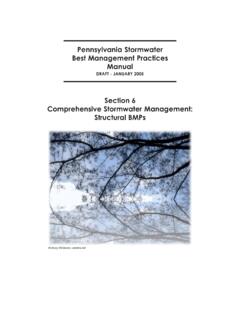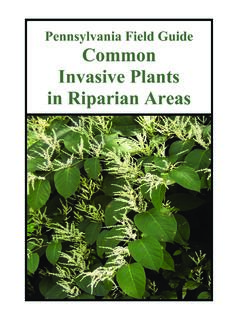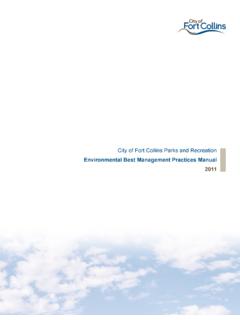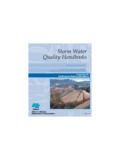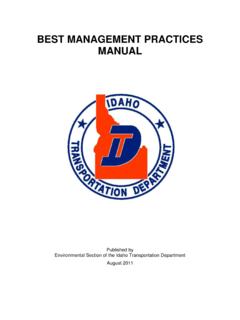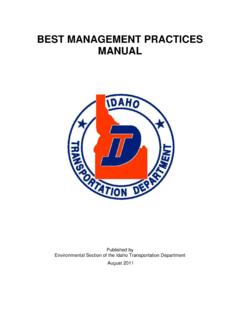Transcription of Pennsylvania Stormwater Best Management Practices Manual
1 Section 2 Stormwater and Pennsylvania s Natural SystemsPennsylvania StormwaterBest Management PracticesManualDRAFT - JANUARY 2005 This page intentionally left Pennsylvania Stormwater Management ManualSection 2 - Stormwater and Pennsylvania s Natural SystemsSection 2 Stormwater and Pennsylvania s Natural Hydrologic Ground Water Recharge and Stream Base Surface Impacts of Development and Impervious and Water Watersheds and Stream Natural Systems of Pennsylvania Stormwater Management ManualSection 2 - Stormwater and Pennsylvania s Natural SystemsSection 2 Stormwater and Pennsylvania s Natural SystemsImpervious surfaces greatly increase the volume and rate of Stormwater produced by the land surface,which can have damaging impacts related flooding, groundwater recharge, stream baseflow, andstream channel shape.
2 This Stormwater runoff carries with it the various pollutants that haveaccumulated on the man-made landscape. The development of measures that prevent or reducethese hydrologic and chemical impacts is the primary purpose of this Manual , but before specificBMPs can be described, the processes of rainfall and surface runoff must be Hydrologic CycleThe hydrologic cycle is a dynamic system in constantmovement. The cycle s dynamic quality the movement ofrainfall from atmosphere to the land surface, where vegetativesystems transpire and surface and groundwater pathwaysconvey water back to the ocean must be sustained fortruly effective Stormwater Management .
3 A simplifiedschematic of the hydrologic cycle is shown in Figure 2-1. Thecycle for an average year in a typical Pennsylvania watershed,the Brandywine Creek, is shown as a flow chart in Figure one part of the system means impacting other partsof the system, as the water balance is maintained. Thereare five major components to the water cycle - precipitation,infiltration, evapotranspiration, groundwater recharge, andrunoff. Altering one component of the water cycle invariablytranslates into changes in other elements of the cycle. Forexample, paving the land surface reduces the amount of infiltration and evapotranspiration whileincreasing the amount of runoff.
4 Stormwater BMPs are intended to help maintain the natural watercycle 2-1. Natural Hydrologic Cycle for an Undisturbed Acre ofLand The hydrologic cycle is a dynamicsystem in constant movement. The hydrologic cycle is comprised offive major components: precipitation,infiltration, evapotransporation,groundwater recharge, and surfacerunoff. Impacting one part of this systemmeans impacting other parts of thesystem, to maintain the waterbalance. 2-19 Draft Pennsylvania Stormwater Management ManualSection 2 - Stormwater and Pennsylvania s Natural PrecipitationPrecipitation in Pennsylvania reflects a relativelyhumid pattern, with average annual precipitationranging from under 34 inches to more than 50inches per year (Figure 2-3, NOAA, 2002).
5 Stormfrequency data demonstrates some consistencyfrom one city or region to another (Table 2-1). Stormfrequency is derived based on the statisticalprobability of a storm occurring in a given year. Thatis, a 10-year, 24-hour storm has a 10 percentchance of occurring in any single year, a 50-yearstorm has a 2 percent chance, and a 100-yearstorm, a 1 percent chance. Stormwatermanagement has historically focused on managingthe flood effects from these large hurricanes occasionally track across thestate, bringing with them heavy rainfalls and flooding. The pathways of major flood producinghurricanes that have impacted the state over the past four decades as shown in Figure 2-4.
6 These Precipitation in Pennsylvania reflects a relativelyhumid pattern, with average annual precipitationranging from under 34 inches to more than 50inches per year. Tropical hurricanes occasionally track across thestate, bringing with them heavy rainfalls andflooding. Precipitation varies by season, but is welldistributed throughout the year, with most of theannual volume of rainfall occurring in small stormevents of modest 2-2. Annual Hydrologic Cycle as Flowchart for the Brandywine Creek, (Cahill, 1995).2-20 Draft Pennsylvania Stormwater Management ManualSection 2 - Stormwater and Pennsylvania s Natural Systemscoastal storms have been responsible for much of the actual flood damage experienced inPennsylvania over the years.
7 These extreme flood events are only one component of also varies by season, but rainfall is well distributed throughout the year, occurring infrequent events of modest size. Most of the rainfall in Pennsylvania occurs in relatively small stormevents, as indicated in Figures 2-5 and 2-6. Over half of the average annual rainfall occurs in stormsTable 2-1. Rainfall Events of 24-Hour Duration in PA (inches) (Source: NOAA National Weather ServicePrecipitation Frequency Data Server, 2004)2-year5-year 10-year 50-year of Occurrence (Years)LocationFigure 2-3. Average Annual Precipitation in Pennsylvania , 1971 1990 (NOAA, 2002)2-21 Draft Pennsylvania Stormwater Management ManualSection 2 - Stormwater and Pennsylvania s Natural Systemsof less than 1 inch (in 24 hours).
8 Well over 75 percent of the average annual rainfall occurs in stormsof 2 inches or less, and over 95 percent of average annual rainfall occurs in storms of 3 inches orless. A 2-year frequency rainfall is approximately to 3 inches of precipitation. When stormwatermanagement only addresses large events (2-year storms and greater), much of the actual rainfalland runoff are overlooked (as much as 95% of the annual rainfall). Managing smaller storms thatcompromise the vast majority of the annual rainfall in Pennsylvania is also 2-5. Number of Storm Events by Event Magnitude, (Cahill, 2004)89715795103010002000300040005000600 04" +3" - 4"2" - 3"1" - 2" " - 1"Storm Magnitude (inches)Number of StormsFigure 2-4.
9 Major Flood-Producing Hurricanes through Northeastern United States2-22 Draft Pennsylvania Stormwater Management ManualSection 2 - Stormwater and Pennsylvania s Natural InfiltrationOn an average annual basis, most rainfall soaks into the soilmantle under natural conditions. This is because there areso many small storm events that produce little if any runofffrom natural surfaces, as indicated in Figure 2-1. Thedominance of infiltration in the overall water cycle is especiallytrue when considering that most rainfall events are small. Oneinch of rain, falling in undisturbed woodlands on the moderately draining soils typical in much of thestate, produces little or no runoff.
10 Most rainfall soaks into the soil, is stored in surface depressions, oris intercepted by vegetation as shown in Figure 2-7. Even in a larger rainfall event of inches in24 hours, the natural system absorbs inches according to the Runoff Curve Number Method, oralmost 70 percent of the EvapotranspirationMost of the rainfall that soaks into the soil returns to theatmosphere through evaporation and transpiration throughvegetation as shown in Figure 2-2. The vegetation itself alsointercepts and slows the rainfall, reducing its erosive energy,reducing overland flow of runoff, and allowing infiltration andevaporation to occur. The root systems of plants providepathways for water precipitation passes the root zone and is able to movefarther downward to the zone of saturation, or water or months later this precipitation emerges from springsor seeps as groundwater recharge or baseflow.
